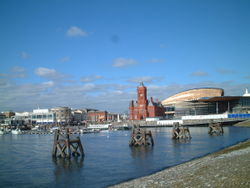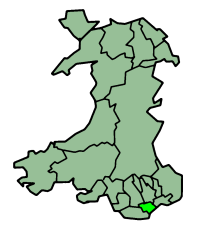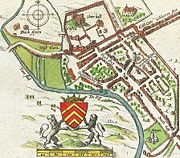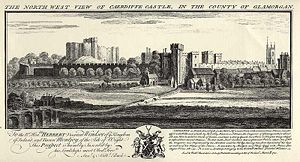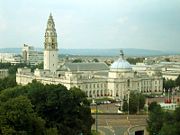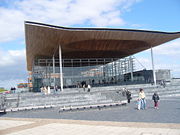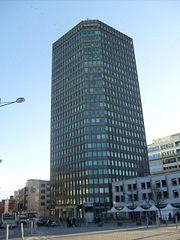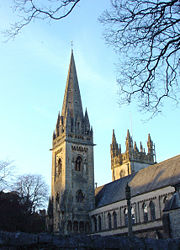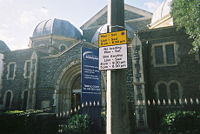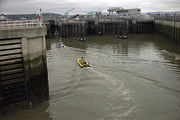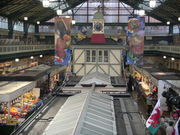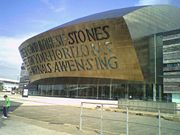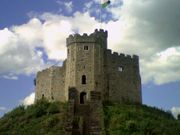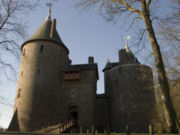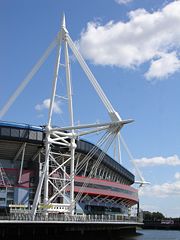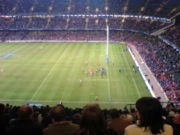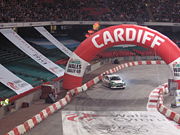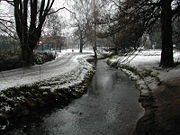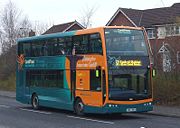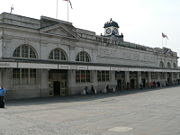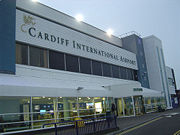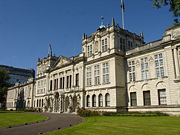Cardiff
2008/9 Schools Wikipedia Selection. Related subjects: British Cities; Great Britain
| City and County of Cardiff Dinas a Sir Caerdydd |
|||
| Cardiff Bay | |||
|
|||
| Motto: Y ddraig goch ddyry cychwyn (The red dragon will lead the way) |
|||
| Location of the city of Cardiff (Light Green) within Wales (Dark Green) | |||
| Coordinates: | |||
|---|---|---|---|
| Sovereign state | United Kingdom | ||
| Constituent country | Wales | ||
| Region | South Wales | ||
| Historic county | Glamorgan | ||
| Government | |||
| - Cardiff Council Leader | Rodney Berman | ||
| - Welsh Assembly |
List
|
||
| - UK Parliament |
List
|
||
| - European Parliament | Wales | ||
| Area | |||
| - City | 2.6 sq mi (6.652 km²) | ||
| - Urban | 54.1 sq mi (140 km²) | ||
| Population (2001*; otherwise 2006 local gov. est.) | |||
| - City | 317,500 | ||
| - Density | 11,375.2/sq mi (4,392/km²) | ||
| - Urban | 327,706 * | ||
| - Demonym | Cardiffian | ||
| - Ethnicity | 91.57% White 1.99% Mixed 3.96% S. Asian 1.28% Black 1.20% Chinese or other. |
||
| Time zone | GMT ( UTC0) | ||
| - Summer ( DST) | BST ( UTC+1) | ||
| Post codes | CF3, CF5, CF10, CF11, CF14, CF15, CF23, CF24 | ||
| Area code(s) | 029 | ||
| Vehicle code | CA-CO | ||
| Police Force | South Wales Police | ||
| Fire Service | South Wales Fire and Rescue Service | ||
| Ambulance Serivce | Welsh Ambulance Service | ||
| Website: http://www.cardiff.gov.uk/ | |||
Cardiff (English: Cardiff IPA: /'kɑːdɪf/, Welsh: Caerdydd ) is the capital and the largest city and county in Wales. As well as being the political capital, it is Wales's capital of business, education, sport, tourism, culture, media and government. According to recent local government estimates, the population of the unitary authority area is 317,500.
The city of Cardiff is the county town of the historic county of Glamorgan (and later South Glamorgan). Cardiff is part of the Eurocities network of the largest European cities. Cardiff Urban Area covers a slightly larger area, including Dinas Powys, Penarth and Radyr. It was a small town until the early 19th century and came to prominence as a major port for the transport of coal following the arrival of industry in the region. Cardiff was made a city in 1905, and proclaimed capital of Wales in 1955. Since the 1990s Cardiff has seen significant development with a new waterfront area at Cardiff Bay which contains the new Welsh Assembly Building, and the city centre is currently undergoing a major redevelopment. International sporting venues in the city include the Millennium Stadium (rugby union and football) and SWALEC Stadium (cricket). Cardiff is a significant tourist centre with 11.7 million visitors in 2006.
Cardiff is home to the biggest media sector in the United Kingdom outside London, being home to a number of television studios and radio stations, such as the BBC, ITV, HTV, S4C as well as independent broadcasters.
History
Origins of the name
The name Cardiff and its Welsh equivalent Caerdydd are both believed by most modern experts to derive from post-Roman Brythonic words meaning "the fort on the Taff". "Dydd" or "Diff" are both modifications of " Taff", the river on which Cardiff Castle stands, with the T mutating to D in Welsh. According to a leading modern authority on toponymy, the Welsh pronunciation of "Caerdyff" as "Caerdydd" shows the colloquial alternation of Welsh "-f" and "-dd".
In the past, antiquarians such as William Camden suggested that the name Cardiff might derive from a name "Caer-Didi" ("the Fort of Didius") given in honour of Aulus Didius Gallus, governor of a nearby province at the time when the Romans established a fort at Cardiff. Although some modern websites repeat this theory as fact, it is refuted by modern scholars on linguistic grounds, with Professor Gwynedd Pierce of Cardiff University recently describing it as "rubbish".
Roman period to the Middle Ages
The history of what is now Cardiff began with a Roman fort on the site, built in 75 CE. As Roman rule in Britannia ended near the start of the 5th century the fort was abandoned.
In 1091 Robert Fitzhamon began work on the castle keep within the walls of the old Roman fort. Cardiff Castle has been at the heart of the city ever since. The castle was substantially altered and extended during the Victorian period by John Crichton-Stuart, 3rd Marquess of Bute, and the architect William Burges. Original Roman work can, however, still be distinguished in the wall facings.
Soon a little town grew up in the shadow of the castle, made up primarily of settlers from England. Cardiff had a population of between 1,500 and 2,000 in the Middle Ages, a relatively normal size for a Welsh town in this period. By the end of the 13th century, Cardiff was the only town in Wales with a population exceeding 2,000, but it was relatively small compared to most other notable towns in the Kingdom of England.
Cardiff was a busy port in the Middle Ages, in 1327, it was declared a Staple port. In the early 12th century a wooden palisade was erected around the city to protect it.
In 1404 Owain Glyndwr burned Cardiff and took Cardiff Castle. As the town was still very small, most of the buildings were made of wood and the town was reduced to ashes. However, the town was rebuilt not long after and began to flourish once again.
County town of Glamorganshire
In 1536, the Act of Union between England and Wales led to the creation of the shire of Glamorgan. Cardiff was made the county town. Around this same time the Herbert family became the most powerful family in the area. In 1538, Henry VIII closed the Dominican and Franciscan friaries in Cardiff, the remains of which were used as building materials. A writer around this period described Cardiff: "The River Taff runs under the walls of his honours castle and from the north part of the town to the south part where there is a fair quay and a safe harbour for shipping."
Cardiff had become a Free Borough in 1542. In 1573, it was made a head port for collection of customs duties. In 1581, Elizabeth I granted Cardiff its first royal charter. By 1602 Pembrokeshire historian George Owen described Cardiff as "the fayrest towne in Wales yett not the welthiest. The town gained a second Royal Charter in 1608. During the Second English Civil War, St. Fagans just to the west of the town, played host to the Battle of St. Fagans. The battle, between a Royalist rebellion and a New Model Army detachment, was a decisive victory for the Parliamentarians and allowed Oliver Cromwell to conquer Wales. It is the last major battle to occur in Wales, with a total death toll of about 200 (mostly Royalist) soldiers killed.
In the ensuing century Cardiff was at peace. In 1766, John Stuart, 1st Marquess of Bute married into the Herbert family and was later created Baron Cardiff. In 1778, he began renovations on Cardiff Castle. In the 1790s a racecourse, printing press, bank and coffee room all opened, and Cardiff gained a stagecoach service to London. Despite these improvements, Cardiff's position in the Welsh urban hierarchy had declined over the 18th century. Iolo Morgannwg called it "an obscure and inconsiderable place", and the 1801 census found the population to be only 1,870, making Cardiff only the twenty-fifth largest town in Wales, well behind Merthyr and Swansea.
Building of the docks
In 1793, John Crichton-Stuart, 2nd Marquess of Bute was born. He would spend his life building the Cardiff docks and would later be called "the creator of modern Cardiff". In 1815, a twice-weekly boat service between Cardiff and Bristol was established. In 1821, the Cardiff Gas Works was established.
The town grew rapidly from the 1830s onwards, when the Marquess of Bute built a dock which eventually linked to the Taff Vale Railway. Cardiff became the main port for exports of coal from the Cynon, Rhondda, and Rhymney valleys, and grew at a rate of nearly 80% per decade between 1840 and 1870. Much of the growth was due to migration from within and outside Wales: in 1851, a quarter of Cardiff's population were English-born and more than 10% had been born in Ireland. By the 1881 census, Cardiff had overtaken both Merthyr and Swansea to become the largest town in Wales. Cardiff's new status as the premier town in South Wales was confirmed when it was chosen as the site of the University College South Wales and Monmouthshire in 1893.
Cardiff faced a challenge in the 1880s when David Davies of Llandinam and the Barry Railway Company promoted the development of rival docks at Barry. Barry docks had the advantage of being accessible in all tides, and David Davies claimed that his venture would cause "grass to grow in the streets of Cardiff". From 1901 coal exports from Barry surpassed those from Cardiff, but the administration of the coal trade remained centred on Cardiff, in particular its Coal Exchange, where the price of coal on the British market was determined and the first million-pound deal was struck in 1907. The city also strengthened its industrial base with the decision of Guest, Keen and Nettlefolds, owners of the Dowlais Ironworks in Merthyr, to build a new steelworks close to the docks at East Moors in 1890.
City and capital city status
King Edward VII granted Cardiff city status on 28 October 1905, and the city acquired a Roman Catholic Cathedral in 1916. In subsequent years an increasing number of national institutions were located in the city, including the National Museum of Wales, Welsh national war memorial, and the University of Wales registry - although it was denied the National Library of Wales, partly because the library's founder, Sir John Williams, considered Cardiff to have "a non-Welsh population".
After a brief post-war boom, Cardiff docks entered a prolonged decline in the interwar period. By 1936, their trade was less than half its value in 1913, reflecting the slump in demand for Welsh coal. Bomb damage during the Cardiff Blitz in World War II included the devastation of Llandaff Cathedral, and in the immediate postwar years the city's link with the Bute family came to an end.
The city was proclaimed capital city of Wales on 20 December 1955, by a written reply by the Home Secretary Gwilym Lloyd George. Caernarfon had also vied for this title. Cardiff therefore celebrated two important anniversaries in 2005. The Encyclopedia of Wales notes that the decision to recognise the city as the capital of Wales "had more to do with the fact that it contained marginal Conservative constituencies than any reasoned view of what functions a Welsh capital should have". Although the city hosted the Commonwealth Games in 1958, Cardiff only became a centre of national administration with the establishment of the Welsh Office in 1964, which later prompted the creation of various other public bodies such as the Arts Council of Wales and the Welsh Development Agency, most of which were based in Cardiff.
The East Moors Steelworks closed in 1978 and Cardiff lost population during the 1980s, consistent with a wider pattern of counter urbanisation in Britain. However, it recovered and was one of the few cities (outside London) where population grew during the 1990s. During this period the Cardiff Bay Development Corporation was promoting the redevelopment of south Cardiff; an evaluation of the regeneration of Cardiff Bay published in 2004 concluded that the project had "reinforced the competitive position of Cardiff" and "contributed to a massive improvement in the quality of the built environment", although it had failed "to attract the major inward investors originally anticipated".
In the 1999 devolution referendum, Cardiff voters rejected the establishment of the National Assembly for Wales by 55.4% to 44.2% on a 47% turnout, which Denis Balsom partly ascribed to a general preference in Cardiff and some other parts of Wales for a 'British' rather than exclusively 'Welsh' identity. The relative lack of support for the Assembly locally, and difficulties between the Welsh Office and Cardiff Council in acquiring the original preferred venue, Cardiff City Hall, encouraged other local authorities to bid to house the Assembly. However, the Assembly eventually located at Crickhowell House in Cardiff Bay in 1999; in 2005, a new debating chamber on an adjacent site, designed by Richard Rogers, was opened.
The city was county town of Glamorgan until the council reorganisation in 1974 paired Cardiff and the now Vale of Glamorgan together as the new county of South Glamorgan. Further local government restructuring in 1996 resulted in Cardiff city's district council becoming a unitary authority, the City and County of Cardiff, with the addition of Creigiau and Pentyrch.
Governance
Local government
Since local government reorganisation in 1996, Cardiff has been governed by The City and County Council of Cardiff, which is based at County Hall in Atlantic Wharf, Cardiff Bay. Voters elect 75 councillors every four years, with the next elections due to be held in 2012.
Since the 2004 local elections, no individual political party has held a majority on Cardiff County Council. The Liberal Democrats have 35 councillors, the Conservatives have 17, Labour have 13, Plaid Cymru have 7 and three councillors sit as Independents. The Leader of the Council, Cllr Rodney Berman, is from the Liberal Democrats.
The Liberal Democrats and Plaid Cymru have formed a partnership administration to run the council.
National Assembly for Wales
The National Assembly for Wales has been based in Cardiff Bay since its formation in 1999. The building which is now known as the Senedd (Welsh for Legislature, Parliament or Senate) was opened on 1 March 2006, by The Queen. The executive and civil servants of the Welsh Assembly Government are based in Cardiff's Cathays Park while the Assembly Members, the Assembly Parliamentary Service and Ministerial support staff are based in Cardiff Bay. Cardiff elects four constituency Assembly Members (AMs) to the Assembly, with the individual constituencies for the Assembly being the same as for the UK Parliament. All of the city's residents have an extra vote for the South Wales Central region which increases proportionality to the Assembly. The most recent Welsh Assembly elections were held on 3 May 2007.
Political representation
Cardiff is presently split into four parliamentary constituencies which form the electoral basis for elections to the United Kingdom Parliament and the National Assembly for Wales.
The constituencies and their representatives are:
- Cardiff Central: MP Jenny Willott, AM Jenny Randerson (Both Liberal Democrat)
- Cardiff North: MP Julie Morgan (Labour), AM Jonathan Morgan (Conservative)
- Cardiff South and Penarth: MP Alun Michael, AM Lorraine Barrett (Both Labour)
- Cardiff West: MP Kevin Brennan, AM Rhodri Morgan (Both Labour)
The South Wales Central Assembly Region elects four Assembly Members to serve the area covered by Cardiff, Rhondda-Cynon-Taf and the Vale of Glamorgan local authority areas. These are currently:
- David Melding (Conservative)
- Andrew R. T. Davies (Conservative)
- Leanne Wood (Plaid Cymru)
- Christopher Franks (Plaid Cymru)
Famous politicians who have represented Cardiff constituencies include:
- Lord Callaghan
- George Thomas, 1st Viscount Tonypandy
Cardiff is part of the Wales constituency in European Parliament elections - the current MEP is Glenys Kinnock, who has represented the constituency since 1999.
Geography
Cardiff is a relatively flat city bounded by hills on the outskirts to the east, north and west. Its geographic features were influential in its development as the world's largest coal port, most notably its proximity and easy access to the coal fields of the south Wales valleys.
Cardiff is built on reclaimed marshland on a bed of Triassic stones; this reclaimed marshland stretches from Chepstow to the Ely Estuary, which is the natural boundary of Cardiff and the Vale of Glamorgan. Triassic landscapes are usually shallow and low-lying which accounts and explains Cardiff's flatness. The classic Triassic marl, sand and conglomerate rocks are used predominantly throughout Cardiff as building materials. Many of these Triassic rocks have a purple complexion, especially the coastal marl found near Penarth. One of the Triassic rocks used in Cardiff is "Radyr Stone", a freestone which as it name suggests is quarried in the Radyr district. Cardiff has also imported some materials for buildings: Devonian sandstones (the Old Red Sandstone) from the Brecon Beacons has been used. Most famously, the buildings of Cathays Park, the civic centre in the centre of the city, are built of Portland stone which was imported from Dorset. A widely used building stone in Cardiff is the surreal yellow-grey Liassic limestone rock of the Vale of Glamorgan, including the very rare "Sutton Stone", a conglomerate of lias limestone and carboniferous limestone that is, apart from Radyr Stone, the only free-stone in south-east Wales (freestones can be cut to a perfectly smooth surface).
Cardiff is bordered to the west by the rural district of the Vale of Glamorgan, which is also known as The Garden of Cardiff, to the east by the city of Newport, to the north by the South Wales Valleys and to the south by the Severn Estuary and Bristol Channel. The River Taff winds through the centre of the city and together with the River Ely flows into the freshwater lake of Cardiff Bay. A third river, the Rhymney flows through the east of the city entering directly into the Severn Estuary.
Cardiff is situated near the Glamorgan Heritage Coast, stretching westward from Penarth and Barry (which are commuter towns of Cardiff), with its striped yellow-blue Jurassic "lias" limestone cliffs that thrust outwards towards the Bristol Channel. The Glamorgan coast is the only part of the Celtic Sea that has exposed Jurassic ( blue lias) geology. This west facing stretch of coast, which takes the brunt of brutal Atlantic westerlies and has reefs, sandbanks and serrated cliffs aplenty (like Cornwall) was a ship graveyard during the age of sail; ships sailing up to Cardiff during the industrial era often never made it as far as Cardiff as most were wrecked around this hostile coastline during brutal west/south-westerly gales. Consequently, just like its Celtic cousin in Cornwall, smuggling, deliberate shipwrecking and attacks on ships became a way of life for many people living in the small coastal villages of the Vale.
Cityscape
Roughly speaking, "Inner Cardiff" can be considered to consist of the following wards: Penylan, Plasnewydd, Gabalfa, Roath, Cathays, Adamsdown and Splott ward on the north and east of the city centre, and Butetown, Grangetown, Riverside and Canton to the south and west. The inner-city areas to the south of the A4161 road known as the "Southern Arc" are, with the exception of affluent and trendy Cardiff Bay, some of the poorest districts of Wales with low levels of economic activity and high ethnic minority populations. On the other hand Gabalfa, Plasnewydd and Cathays north of the 'arc' have very large student populations, and Pontcanna north of Riverside and alongside Canton is a favourite for young professionals and media types. Penylan which lies to the north east side of Roath Park is an affluent area popular with those with older children and the retired.
"Suburban Cardiff" can be broken down into three distinct areas. To the west lie Ely, Caerau and Fairwater which contain some of the largest housing estates in the United Kingdom. With the exception of some of the outlying privately built estates at Michaelston Super Ely and 1930s developments near Waun-Gron Road, this is an economically disadvantaged area with high numbers of unemployed households. Culverhouse Cross is a more affluent western area of the city. Radyr, Llandaff, Llandaff North, Whitchurch & Tongwynlais, Rhiwbina, Heath, Llanishen, Lisvane, and Cyncoed which lie in an arc from the north west to the north east of the centre can be considered the main middle class suburbs of the city. In particular, Cyncoed, Radyr and Lisvane contain some of the most expensive housing in Wales. Further to the east lie the wards of Pontprennau & Old St Mellons, Rumney, Pentwyn, Llanrumney and Trowbridge. The latter three are again largely of public housing stock, although new private housing is being built in Trowbridge in considerable number. Pontprennau is the newest 'suburb' of Cardiff, whilst Old St Mellons has a history going back to the Norman Conquest in the 11th century.
To the north west of the city lies a region that may be called "Rural Cardiff" containing the villages of St. Fagans, Creigiau, Pentyrch, Tongwynlais and Gwaelod-y-garth. St. Fagans, home to the Museum of Welsh Life, is protected from further development.
| Climate chart for Cardiff | |||||||||||
|---|---|---|---|---|---|---|---|---|---|---|---|
| J | F | M | A | M | J | J | A | S | O | N | D |
|
119
8
2
|
91
8
2
|
89
11
4
|
65
13
5
|
65
17
8
|
66
19
11
|
61
22
13
|
90
21
13
|
104
18
10
|
117
15
8
|
117
11
4
|
128
9
3
|
| temperatures in °C precipitation totals in mm source: Met Office |
|||||||||||
|
Imperial conversion
|
|||||||||||
Climate
Cardiff has a temperate climate where summers and winters are generally mild. More specifically Cardiff has an oceanic climate, with prevailing winds blowing in from the south-west over the Atlantic Ocean.
Cardiff has a relatively dry climate compared with most of Wales, with an average rainfall of 1,065 millimetres (41.9 in). It is also a relatively mild city, with an average January temperature of 4.5 °C (40.1 °F) and an average July temperature of 16 °C (61 °F)
Demography
| Year | Population of Cardiff |
| 1801 | 6,342 |
| 1851 | 26,630 |
| 1861 | 48,965 |
| 1871 | 71,301 |
| 1881 | 93,637 |
| 1891 | 142,114 |
| 1901 | 172,629 |
| 1911 | 209,804 |
| 1921 | 227,753 |
| 1931 | 247,270 |
| 1941 | 257,112 |
| 1951 | 267,356 |
| 1961 | 278,552 |
| 1971 | 290,227 |
| 1981 | 274,500 |
| 1991 | 272,557 |
| 2001 | 292,150 |
| 2006 | 317,500* |
|
which refers to the local authority area and is estimated by the Office for National Statistics |
|
Following a period of decline during the 1970s and 1980s, Cardiff's population is growing. The local authority area had an estimated population of more than 317,500 in 2006, compared to a 2001 Census figure of 305,353. According to Census 2001 data, Cardiff was the 14th largest settlement in the United Kingdom, and the 21st largest urban area.
Official estimates derived from the census regarding the city's total population have been disputed. The city council has published two articles that argue the 2001 census seriously under reports the population of Cardiff and, in particular, the ethnic minority population of some inner city areas.
Cardiff has a ethnically diverse population due to its past trading connections, post-war immigration and the large numbers of foreign students who attend university in the city. The ethnic make-up of Cardiff's population at the time of the 2001 census was: 91.6% white, 2% mixed race, 4% South Asian, 1.3% Black, 1.2% Other ethnic origin. According to a report published in 2005, over 30,000 people from an ethnic minority live in Cardiff, around 8.4% of the city's total - many of these communities live in Butetown, where ethnic minorities make up around a third of the total population. This diversity, and especially that of the city's long-established African and Arab communities, has been celebrated in a number of cultural exhibitions and events, along with a number of books which have been published on this subject.
Religion
Since 1922 Cardiff has included the suburban cathedral 'village' of Llandaff, whose bishop is currently Archbishop of Wales. There is also a Roman Catholic cathedral in the city. Since 1916 Cardiff has been the seat of a Catholic archbishop, but there appears to have been a fall in the estimated Catholic population, with estimated numbers in 2006 being around 25,000 less than in 1980.. Likewise, the Jewish population of the city has also appeared to have fallen—there are currently two synagogues in Cardiff, one in Cyncoed and one in Moira Terrace, as opposed to seven at the turn of the 20th century. There are a significant number of nonconformist chapels, an early-20th century Greek Orthodox church and eleven mosques.
In the 2001 census 66.9% of the city's population described themselves as Christian, below the Welsh and UK average, while 3.7% described themselves as Muslim, significantly above the Welsh average but in line with the UK average. The proportion of people declaring themselves to be Hindu, Sikh and Jewish were all considerably higher than the Welsh averages, but less than the UK figures. 18.8% stated they had no religion, while 8.6% did not state a religion.
Islam
Cardiff has one of the longest-established Muslim populations in the UK, started by Yemeni sailors who settled in the city during the 19th century. The first mosque in the UK (on the site of what is now known as the Al-Manar Islamic Centre) opened in 1860 in the Cathays district of Cardiff. Cardiff is now home to over 11,000 Muslims from many different nationalities and backgrounds.
Hinduism
The city has been home to a sizable Hindu community since Indian immigrants settled there during the 1950s and 1960s. The first Hindu temple in the city was opened in Grangetown on April 6, 1979 on the site of an abandoned printing press (which itself was the former site of a synagogue). The 25th anniversary of the temple's founding was celebrated in September 2007 with a parade of over 3000 people through the city centre, including Hindus from across the United Kingdom and members of Cardiff's other religious communities. Today, there are over 2000 Hindus in Cardiff, worshiping at three temples across the city.
Economy
As the capital city of Wales, Cardiff is the main engine of growth in the Welsh economy. The economy of Cardiff and adjacent areas makes up nearly 20% of Welsh GDP and 40% of the city’s workforce are daily in-commuters from the surrounding south Wales area.
Industry has played a major part in Cardiff's development for many centuries. The main catalyst for its transformation from a small town into a big city was the demand for coal required in making iron and later steel, brought to the sea by packhorse from Merthyr Tydfil. This was first achieved by the construction of a 25-mile (40 km) long canal from Merthyr (510 feet above sea-level) to the Taff Estuary at Cardiff. Eventually the Taff Vale Railway replaced the canal barges and massive marshalling yards sprang up as new docks were developed in Cardiff - all prompted by the soaring world-wide demand for coal from the South Wales valleys.
At its peak, Cardiff's port, known as Tiger Bay, became the busiest port in the world and—for some time—the world's most important coal port. In the years leading up to the First World War, more than 10 million tonnes of coal was exported annually from Cardiff. In 1907, Cardiff's Coal Exchange was the first host to a business deal for a million pounds Sterling. After a period of decline, Cardiff's port has started to grow again - over 3 million tonnes of cargo passed through through the docks in 2007.
Today, Cardiff is the principal finance and business services centre in Wales, and as such there is a strong representation of finance and business services in the local economy. This sector, combined with the Public Administration, Education and Health sectors, have accounted for around 75% of Cardiff's economic growth since 1991. The city was recently placed seventh overall in the top 50 European cities in the fDI 2008 Cities of the Future list published by the Foreign Direct Invester (FDI) magazine, and also ranked seventh in terms of attracting foreign investment. Notable companies such as Legal & General, Admiral Insurance, HBOS, Zurich, ING Direct, The AA, Principality Building Society, 118118, British Gas, Brains, SWALEC Energy and BT, all operate large national or regional headquarters and contact centres in the city, some of them based in Cardiff's office towers such as Capital Tower and Brunel House. Other major employers include NHS Wales and the National Assembly for Wales. On 1 March 2004, Cardiff was granted Fairtrade City status.
Cardiff is the one of the most popular tourist destination cities in the United Kingdom, with one survey recording just under 12 million visitors in 2006. One result of this is that one in five employees in Cardiff are based in the distribution, hotels and restaurants sector, highlighting the growing retail and tourism industries in the city. There are a large number of hotels of varying sizes and standards in the city, providing almost 9,000 available bed spaces.
The majority of Cardiff's shopping portfolio is in the city centre around Queen Street and St. Mary's Street, with large suburban retail parks located in Cardiff Bay, Culverhouse Cross, Newport Road and Pontprennau, together with markets in the city centre, Splott and Leckwith. Cardiff is also home to the oldest record shop in the world in Spillers Records, which was established in 1894. A major £675 million regeneration programme for Cardiff's St. David's Centre is currently underway which, when completed in 2009, will provide a total of 1,400,000 square feet (130,000 m²) of shopping space, making it one of the largest shopping centres in the United Kingdom.
Cardiff is home to the Welsh media and the UK's largest film, TV & multimedia sector outside London with BBC Wales, S4C and ITV Wales all having studios in the city. In particular, there is a large independent TV production industry sector of over 600 companies, employing around 6000 employees and with a turnover estimated at £350m.
Cardiff is currently enjoying several regeneration projects such as extension to the St David's Centre and surrounding areas of the city centre, and the $1.4billion International Sports Village in Cardiff Bay which will play a part in London 2012 Olympics. It features the only Olympic-size swimming pool in Wales, the Cardiff International Pool, which opened on 12 January 2008.
Landmarks and attractions
Cardiff has many landmark buildings such as the Millennium Stadium, Pierhead Building and the National Assembly for Wales. However Cardiff is also famous for Cardiff Castle, St David's Hall, Llandaff Cathedral, the Wales Millennium Centre. A prominent future landmark in Cardiff Bay, Bay Pointe which is set to include Wales' tallest building, has been granted planning permission.
Cardiff Castle is a major tourist attraction in the city and is situated in the heart of the city centre, near the main shopping area of Queen Street and St. Mary's Street. The National History Museum at St Fagans in Cardiff is a large open air museum housing dozens of buildings from throughout Welsh history that have been moved to the site in Cardiff.
The Civic Centre in Cathays Park comprises a collection of Edwardian buildings such as the City Hall, National Museum and Gallery of Wales, Cardiff Crown Court, and buildings forming part of Cardiff University, together with more modern civic buildings. These buildings surround a small green space containing the Welsh National War Memorial and a number of other smaller memorials.
Other major tourist attractions are the Cardiff Bay regeneration sites which include the recently opened Wales Millennium Centre and the Senedd, and many other cultural and sites of interest including the Cardiff Bay Barrage and the famous Coal Exchange. The New Theatre was founded in 1906 and completely refurbished in the 1980s. Until the opening of the Wales Millennium Centre in 2004, it was the premier venue in Wales for touring theatre and dance companies. Other venues which are popular for concerts and sporting events include Cardiff International Arena, St David's Hall and the Millennium Stadium.
In total, Cardiff has over 1,000 listed buildings. These range from the more prominent buildings such as the castles, to smaller buildings, houses and structures.
Cardiff has walks of special interest for tourists and ramblers alike, such as the Centenary Walk, which runs for 2.3 miles (3.7 km) within Cardiff city centre. This route passes through many of Cardiff's landmarks and historic buildings.
Castles
Complementing Cardiff Castle is a second castle north of the city, called Castell Coch (Welsh: "Red Castle"). The current castle is an elaborately decorated Victorian folly designed by Burges for the Marquess and built in the 1870s. However, the Victorian castle stands on the footings of a much older medieval castle possibly built by Ifor Bach, a regional baron with links to Cardiff Castle also. The exterior has become a popular location for film and television productions.
Situated on the narrowest part of the south Wales coastal plain, Cardiff had a crucial strategic importance in the wars between the Normans (who had occupied lowland Wales) and the Welsh who maintained their hold on the uplands. As a result Cardiff claims to have the largest concentration of castles of any city in the world. As well as Cardiff Castle and Castell Coch, the remains of Twmpath Castle, the Llandaff Bishop's Palace and Saint Fagans Castle are still in existence, whilst the site of Treoda (or Whitchurch Castle) has now been built over.
Culture and recreation
Cardiff many cultural sites varying from the historical Cardiff Castle and out of town Castell Coch to the more modern Wales Millennium Centre and Cardiff Bay. Cardiff was a finalist in the European Capital of Culture 2008. In recent years Cardiff has grown in stature as a tourist destination, with recent accolades including Cardiff being voted the eighth favourite UK city by readers of the Guardian. The city was also listed as one of the top 10 destinations in the UK on the official British tourist boards website Visit Britain, and US travel guide Frommers have listed Cardiff as one of 13 top destinations worldwide for 2008.
Language
Cardiff has a chequered linguistic history with Welsh, English, Latin and Norse dominating at different times. Although it was the Romans who established the "castle on the Taff" it was the Vikings who began developing the maritime trade from which Cardiff was to derive its prosperity. The Vikings—who controlled the Bristol Channel—used Cardiff as a raiding base, a port and a trading post. Many street-names in Cardiff are of Viking origin including Dumballs Road and the oldest street in the city, Womanby Street (Womanby Street is a corruption of the original Norse name Humandaby Street). Welsh was the majority language in Cardiff from the 13th century until the city's explosive growth in the Victorian era. As late as 1850, five of the twelve Anglican churches within the current city boundaries conducted their services exclusively in the Welsh language, while only two worshipped exclusively in English.
A substantial Irish population settled in Cardiff during the 19th century. They were drawn to Cardiff by the work available on major building and engineering projects in the docks and the city itself. The intermingling of the Irish, together with migrants from the West Country, the Midlands and rural Mid Wales is credited with having formed the distinctive flat-vowelled "Cardiff accent" (Roots to Cardiff exhibition, 2007). By 1891 the percentage of Welsh speakers had dropped to 27.9% and only Lisvane, Llanedeyrn and Creigiau remained as majority Welsh-speaking communities. The Welsh language became grouped around a small cluster of chapels and churches, the most notable of which is Tabernacl in the city centre, one of four UK churches chosen to hold official services to commemorate the new millennium. Following the establishment of the city's first Welsh School (Ysgol Gymraeg Bryntaf) in the 1950s, Welsh has slowly regained some ground.
Aided by Welsh-medium education and migration from other parts of Wales, the number of Welsh speakers in Cardiff rose by 14,451 between 1991 and 2001; Welsh is now spoken by 11% of Cardiffians. The highest percentage of Welsh speakers is in Pentyrch, where 15.9% of the population speak the language.
In additional to English and Welsh, the diversity of Cardiff's population (including foreign students) means that a large number of languages are spoken within the city. One study has found that Cardiff has speakers of at least 94 languages, with Somali, Urdu, Bengali and Arabic being the most commonly spoken foreign languages.
Festivals
The Big Weekend Festival is held annually in the city centre during the summer and plays host to free musical performances (from artists such as Jimmy Cliff, Cerys Matthews, the Fun Loving Criminals, Soul II Soul and The Magic Numbers), fairground rides and cultural events such as a Children's Festival that takes place in the grounds of Cardiff Castle. The annual Cardiff Festival claims to be the UK's largest free outdoor festival, attracting over 250,000 visitors in 2007.
Cardiff hosted the National Eisteddfod in 1883, 1899, 1938, 1960 and 1978, and is set to host it again in 2008. Cardiff is unique in Wales in having two permanent stone circles used by the Gorsedd of Bards during Eisteddfodau. The original circle stands in Gorsedd Gardens in front of the National Museum while its 1978 replacement is situated in Bute Park.
Since 1983, Cardiff has hosted the BBC Cardiff Singer of the World competition, a world renowned event on the opera calendar which is held every two years. The city also hosts smaller events such as The Cardiff Design Festival, which began showcasing the best of Welsh design during the summer of 2005, and has since grown into a diverse range of designers exhibiting their work. Cardiff also hosts the Sŵn festival, a multiple venue music festival organised by BBC Radio 1 DJ Huw Stevens. The Cardiff Chinese New Year Celebrations, organised by Cardiff Chinese Community Services, are held annually at the Red Dragon Centre in Cardiff Bay.
Parks

Cardiff is known for its extensive parkland, with parks and other such green spaces covering around 10% of the city's total area. Cardiff's main park, Bute Park (which was formerly the castle grounds) extends northwards from the top of one of Cardiff's main shopping street (Queen Street); when combined with the adjacent Llandaff Fields and Pontcanna Fields to the north west it produces a massive open space skirting the River Taff. Other popular parks include Roath Park in the north, donated to the city by the 3rd Marquess of Bute in 1887 and which includes a very popular boating lake; Victoria Park, Cardiff's first official park; and Thompson's Park, formerly home to an aviary removed in the 1970s.
In 2006 Cardiff won the prestigious Entente Florale award for large cities due to the beauty of its parks and floral displays.
Music and nightlife
The Cardiff music scene is established and wide-ranging. It is the home to the BBC National Orchestra of Wales and Welsh National Opera. It has produced several leading acts itself and, as a capital city, has acted as a springboard for numerous Welsh bands to go and become famous both nationally and internationally. Acts who hail from Cardiff include Charlotte Church, Shirley Bassey, Catatonia, Super Furry Animals, The Oppressed, Kids In Glass Houses, Los Campesinos, The Hot Puppies, Pagan Wanderer Lu, Budgie, and Shakin' Stevens. Also, performers such as The Automatic, Jem, Funeral for a Friend, Lostprophets, Bullet for My Valentine, Stereophonics and Manic Street Preachers all have links with the city.
Cardiff has a strong nightlife and is home to many bars, pubs and clubs. Most clubs and bars are situated in the city centre, especially St. Mary's Street, and more recently Cardiff Bay has built up a strong night scene, with many modern bars & restaurants. The Brewery Quarter on St. Mary's Street is a recently developed venue for bars and restaurant with a central courtyard. Charles Street is also a popular part of the city.
Shopping
Cardiff is one of the top ten retail destinations in the UK, with three main shopping arcades; St. David's Centre, Queens Arcade and the Capitol Centre. The current expansion of St. David's Centre as part of the St. David's 2 project is allowing a huge piece of land between The Hayes and Charles Street to be demolished and redeveloped, bringing around 200 shops, flats and a John Lewis department store to the city. As well as these modern shopping arcades, the city is also home to many Victorian shopping centres, such as High Street Arcade, Castle Arcade, Wyndham Arcade, Royal Arcade and Morgan Arcade.
There are two main shopping streets in the city centre. Queen Street is home to the main chain stores such as Topshop, Topman, Boots, Gap, Dorothy Perkins, Primark, and Zara to name a few. The second main street, St. Mary Street, is home to Wales' oldest and largest department store, Howells, together with smaller independent stores. Also of note is the Hayes, home to Spillers Records, the world's oldest record shop.
Cardiff has a number of markets, including the vast Victorian indoor Cardiff Central Market and the newly-established Riverside Community Market, which specialises in locally-produced organic produce. Several out-of-town retail parks exist, such as Newport Road, Culverhouse Cross, Cardiff Gate and Cardiff Bay.
There have been a number of issues relating to city centre shopping, most recently the cost of parking in the city centre and the experimental banning of private cars on St. Mary's Street. Both have been heavily criticised by some sectors of the media, public and retailers.
Sport
The city has a regional rugby union team, the Cardiff Blues, who play at their Cardiff Arms Park stadium. The city also has a rugby league team named the Cardiff Demons, as well as several amateur rugby clubs.
Cardiff's main professional football club, Cardiff City F.C. (nicknamed the Bluebirds), currently play in the English Coca-Cola Football League Championship. Their present stadium is Ninian Park, however a new stadium is currently under construction, which is due to be opened in 2009 and will be shared with the Cardiff Blues. Cardiff has numerous smaller clubs who play in the Welsh Football System.
Cardiff is also home to a county cricket side, Glamorgan CCC. The team play at the city centre's SWALEC Stadium, which has undergone a multi-million pound improvement in order to host a Test Match as part of the 2009 Ashes series.
Cardiff's professional ice-hockey team, the Cardiff Devils, play in their temporary arena in Cardiff Bay. The capital is the one of the centres of British Baseball, and hosts the annual England-Wales international game every four years, usually at Roath Park.
The Wales Empire Swimming Pool was demolished in 1998 to make way for the Welsh national stadium, the Millennium Stadium. The replacement pool, the Cardiff International Pool was opened on 12 January 2008 in Cardiff Bay as part of the International Sports Village, and is the only Olympic-standard swimming pool in Wales.
The city also features an international sporting venue, the 74,500 capacity Millennium Stadium, where the Welsh rugby team and the Welsh national football team plays. The Millennium Stadium also doubles up as a venue for other concerts and events such as motorsport's World Rally Championship as part of Wales Rally GB, with the first ever indoor special stages of the World Rally Championship being held at the Millennium Stadium in September 2005. It has continued to host this annual event.
Notable people
Many notable people have hailed from Cardiff, ranging from historical figures such as the 12th century Welsh leader Ifor Bach and the 17th century pirate Henry Morgan to more recent figures such as Roald Dahl, Michael Aspel, and Griff Rhys Jones. In particular, the city has been home to many sports stars such as Ryan Giggs, Tanni Grey-Thompson, Colin Jackson and John Toshack (the current manager of the Wales national football team) as well as many Premier League, Football League and international footballers.
Cardiff is also well-known for its musicians such as Ivor Novello, after whom the Ivor Novello Awards are named. Shirley Bassey is familiar to many as the singer of three James Bond movie theme tunes, whilst Charlotte Church is famous as a crossover classical/pop singer, and Shakin' Stevens was one of the top selling male artists in the UK during the 1980s. A number of Cardiff-based bands, such as Catatonia and Super Furry Animals were popular during the 1990s.
Transport
Cardiff is the major transport hub in Wales and is the focus for many arterial road and rail routes that connect the city to the rest of Wales and England.
The M4 is the principal motorway in the region that connects Cardiff with Bridgend, Swansea and Carmarthen to the west, and Bristol, Swindon, Reading and London to the east. Cardiff is served by junctions 30 to 33 inclusive of the M4, plus junction 29a leading onto the A48(M). The A470 is another major road within the city that provides an important link with the Heads of the Valleys road, Mid and North Wales. The A4232 (also known as the Peripheral Distributor Road or PDR) when completed, will form part of the Cardiff ring-road system along with the M4 motorway between junctions 30 and 33.
As with many other cities car traffic has caused congestion problems and as such the council has designated bus lanes to improve transport into and out of the city centre. The council has also revealed plans to introduce congestion charging, as in London, but only once there has been significant investment in the city's public transport network.
There are several road and rail bridges that cross the River Taff in Cardiff. These include the Clarence Road Bridge, a comparatively modern bridge which replaced a swing bridge. The original bridge was named after the Duke of Clarence.
Much of Cardiff's central shopping zone is pedestrianised, and further pedestrianisation is planned as part of the current St David's 2 regeneration scheme.
The Taff Trail is a walking and cycle path running for 55 miles (88.5 km) between Cardiff Bay and Brecon in the Brecon Beacons National Park. It runs through Bute Park, Sophia Gardens and many other green areas within Cardiff. It is possible to cycle the entire distance of the Trail almost completely off-road, as it largely follows the River Taff and many of the old disused railways of the Glamorganshire valleys. On Sundays in summer the Beacons Bike Bus enables cyclists to take their bikes into the Beacons and then ride back to Cardiff along the Trail.
Cardiff has a comprehensive bus network, with council-owned Cardiff Bus providing the vast majority of routes in the city and as well as Newport, Penarth, Barry, Cardiff International Airport and Llantwit Major. Veolia Transport Cymru and Stagecoach in South Wales also provide services in the city. Cardiff Bus has introduced "bendy buses" on the popular 17 and 18 routes to Canton, Ely and Caerau and on the Cardiff Bay route. Its hub is Cardiff Central Bus Station.
National Express provides direct services to most cities in the UK, including high frequency services to nearby Swansea and Merthyr Tydfil, as well as major English and Scottish cities. Megabus also operates frequent discounted services to London.
Cardiff has a suburban rail system under the name of Valley Lines, which is operated by Arriva Trains Wales. There are eight lines which serve 20 stations in the city, 26 in the wider urban area (including Taffs Well, Penarth and Dinas Powys) and more than 60 in the South Wales valleys and the Vale of Glamorgan. The council is investigating converting the Cardiff City Line, Coryton Line and Butetown Branch Line into light rail line and extending them in the near future.
Cardiff Central railway station is the largest railway station in Wales with 7 platforms, and one of the busiest in the UK. It provides direct services to major cities such as Newport, Bristol, Birmingham, London, Manchester, Nottingham, Southampton, Portsmouth, Newcastle-upon-Tyne, Edinburgh and Glasgow, as well as serving as an interchange for services from West Wales. There is also a regular shuttle service to Holyhead (for ferries to Ireland) and Wrexham in North Wales.
Cardiff Queen Street railway station is the second busiest in Wales and is the hub for routes via the Valley Lines services that connect the South Wales valleys and the Cardiff suburbs with the city centre. It is located at the eastern end of the city centre, and also provides services to Cardiff Bay.
Two waterbus firms operate half-hourly services from Bute Park in the city centre to Cardiff Bay and onwards to Penarth. Throughout the summer (March to October), boats also depart from Cardiff Bay to take visitors to Flat Holm Island. The Paddle Steamer Waverley and MV Balmoral sail from Britannia Quay (in Roath Basin) to various destinations in the Bristol Channel.
Domestic and international air links to Cardiff and South & West Wales are provided from Cardiff International Airport (CWL), the only international airport in Wales. The airport is situated in the village of Rhoose, 10 miles (16 km) west of the city. There are regular bus services linking the airport with the Cardiff Central Bus Station as well as a train service from Rhoose Cardiff International Airport railway station to Cardiff Central.
Education
Cardiff is home to four major institutions of higher education: Cardiff University, founded by Royal Charter in 1883 as the University College of South Wales and Monmouthshire, is a " red brick" university and member of the Russell Group of leading research led universities; University of Wales Institute, Cardiff (UWIC) gained university status in 1992; The Royal Welsh College of Music & Drama is a conservatoire established in 1949 and is based in the grounds of Cardiff Castle. The University of Glamorgan has a Cardiff campus, Atrium, which is home to the Cardiff School of Creative & Cultural Industries. The total number of higher education students in the city is around 30,000. The city also has two further education colleges: Coleg Glan Hafren and St. David's College, although further education is offered at most high schools in the city.
Cardiff has eighty-six state primary schools (two bilingual, ten Welsh medium), eleven infant schools, ten junior schools and twenty state secondary schools, of which two are Welsh medium. There are also a number of independent schools in the city, including Llandaff Cathedral School, Kings Monkton and Howell's School, a single-sex girls' school (until sixth form). Notable schools include Whitchurch High School (the largest in Wales), Fitzalan High School (which is one of the most multi-cultural state schools in the UK), and Ysgol Gyfun Gymraeg Glantaf, which is the largest Welsh medium secondary in the country.
As well as academic institutions, Cardiff is also home to other educational and learning organisations such as Techniquest, a hands-on science discovery centre that now has franchises throughout Wales, and is part of the Wales Gene Park in collaboration with Cardiff University, NHS Wales and the Welsh Development Agency (WDA). Cardiff is also home of the largest regional office of the International Baccalaureate Organisation (IB). This office is home to the organisation's curriculum and assessment centre, which is responsible for overseeing the creation and grading of various IB assessments.
Health
There are seven NHS hospitals in the city, the largest of which is the University Hospital of Wales, which is also known as 'The Heath' or 'UHW', is the third largest hospital in the UK and deals with most accidents and emergencies. The University Dental Hospital, which provides emergency dental treatment, is also located on this site. Llandough Hospital is located in the south of the city.
The city's newest hospital, St. David's Hospital (built behind the former building) is located in the Canton area and provides services for the elderly and children. Cardiff Royal Infirmary is located on Newport Road, near the city centre. The majority of this hospital was closed in 1999 but with the West Wing remaining open for clinic services, genitourinary medicine and rehabilitation treatment. Rookwood Hospital and Whitchurch Hospital are also located within the city, along with Llandaff and Velindre Hospital (which is run by a separate NHS trust). In addition BUPA has a hospital in the city which is located in Pentwyn.
International relations
Cardiff has twinning arrangements with:
 Luhans'k,
Luhans'k,  Ukraine
Ukraine Pernik, Pernik Province
Pernik, Pernik Province  Bulgaria
Bulgaria Bergen, Hordaland,
Bergen, Hordaland,  Norway
Norway Nantes, Pays de la Loire
Nantes, Pays de la Loire  France
France Stuttgart, Baden-Württemberg,
Stuttgart, Baden-Württemberg,  Germany
Germany- Xiamen, Fujian,
 China
China
A total of thirty countries have a diplomatic presence in Cardiff. Many of these nations, such as Germany, Italy, Switzerland, Denmark, Canada, Thailand and the Czech Republic are represented by honourary consulates. The Republic of Ireland has a permanent consulate, and the British Embassy of the United States operates a satellite office.
Telecommunications
029 is the current telephone dialling code for Cardiff, having previously been 0222 and then 01222. However it is vastly misconceived (in the city but on a larger scale in South Wales) to be 02920 because initially, at the time of the new dialing code system, all numbers began with 20. Currently all newly issued numbers begin with 21. The code includes the neighbouring towns of Penarth, Dinas Powys and Caerphilly.
The city's dialling code was changed on 22 April 2000 from 01222 to 029 in the Big Number Change along with London, Coventry, Portsmouth, Southampton and Northern Ireland in response to the rapid growth of telecommunications in the late 1990s and the impending exhaustion of numbers. This measure increased the numbers of digits in the subscriber telephone number from 6 to 8, therefore vastly increasing the possible telephone numbers available.
Ofcom has allocated the range of telephone numbers from (029) 2018 0000 to (029) 2018 0999 to be used for drama purposes in television and radio. These numbers will not be allocated to telephone companies in the foreseeable future.
